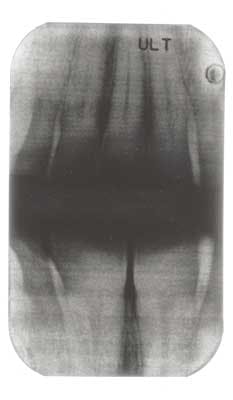Save time and money with these X-ray tips from Carestream Health: Ask the Expert for January 2011
Ask the Expert for January 2011 from Carestream Health
Christopher A. WarrenTechnical Support EngineerImaging ConsultantCarestream DentalExclusive manufacturer of KODAK Dental Systems
Last month we asked you to diagnose the X-ray below and send in your answers on what you think the operator may have done wrong. Today we provide you with the image’s diagnosis!Congratulations to DeeDee Sandhurst from Rathdrum, Idaho, for correctly diagnosing the processing problem below. DeeDee will be awarded a $25 gift card. Great job, DeeDee! Be sure to send in your diagnosis for this month’s Diagnose the X-Ray for a chance to win.
X-ray AnswerDeposits of metallic silver and dirt resulting in black areas and grainy lines, respectively.Dark areas and streaks are often caused by dirty rollers in automatic processors. Occasionally, metallic silver will form on the rollers and come off onto the film during processing. Dirt accumulated on rollers is typically caused by poor processor cleaning and maintenance. Other causes can include chemical contamination (fixer in the developer), poor chemical quality/under-replenished chemistry, or using water to top off or replenish chemistry.Tips and TricksIn order to correct or avoid this problem, I recommend the following:
- Closely follow the processor manufacturer’s weekly, monthly, and quarterly cleaning recommendations. If using Kodak Dental Film, I strongly recommend also using Kodak Dental Chemistry as the two are designed to work optimally together.
- For automatic roller processors, run one or more “cleanup” films every morning after starting the processor. Cleanup film is specifically designed to pick up lint and debris from rollers. Cleanup films are single use only; reusing will result in chemical contamination.
- All replenished solutions should be changed every three to four weeks under normal conditions. Normal use is defined as 30 intraoral films per day. Manufacturers of automatic nonroller-type processors recommend all nonreplenished solutions be changed every two weeks.
- Never add water to top off or replenish any dental chemistry. Water will dilute already partially seasoned or exhausted chemistry, and actually make processing conditions worse.
What did the operator do wrong to achieve this image? Click here to answer. Be sure to look for the cause of the problem and Chris’s recommendation in our next issue!Contact usHave a question or concern about your KODAK dental film? If so, contact Chris. Looking for an authorized dealer?Need more information about KODAK dental film, call (800) 933.8031 or visit www.carestreamdental.com.© Carestream Health, Inc.The KODAK trademark and trade dress are used under license from Kodak.




